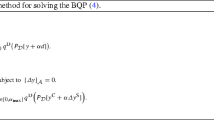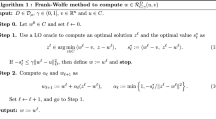Abstract
The gradient projection algorithm for function minimization is often implemented using an approximate local minimization along the projected negative gradient. On the other hand, for some difficult combinational optimization problems, where a starting guess may be far from a solution, it may be advantageous to perform a nonlocal (exact) line search. In this paper we show how to evaluate the piece-wise smooth projection associated with a constraint set described by bounds on the variables and a single linear equation. When the NP hard graph partitioning problem is formulated as a continuous quadratic programming problem, the constraints have this structure.
Similar content being viewed by others
References
Bertsekas, D.P. (1976), On the Goldstein-Levitin-Polyak gradient project method, IEEE trans. Automat. Control, 21, 216–235.
Bertsekas, D.P. (1999), Nonlinear Programming, Athena Scientific, Belmont, MA.
Bertsekas, D.P., Nedić, A. and Ozdaglar, A.E. (2003), Convex Analysis and optimization, Athena Scientific Belmont, MA.
Brucker, P. (1984), An O(n) algorithm for the quadratic knapsack problem, Oper. Res Lett., 3, 163–166.
Calamai, P.H. and Moré, J.J. (1987), Projected gradient methods for linearly constrained problems, Math. Programming, 39, 98–116.
Demyanov, V.F. and Rubinov, A.M. (1970), Approximate Methods in optimizations Problems, American Elsevier, New York.
Dunn, J.C. (1981), Global andasymptotic convergence rate estimates for a class of projected gradient processes, SIAM J. Control Optim., 19, 368–400.
Dunn, J.C. (1987), On the convergence of projected gradient processes to singular critical points, J. Optim. Theory Appl., 55, 203–216.
Dunn, J.C. (1988), Gradient projection methods for systems optimization problems, Control and Dynamic Systems, 29, 135–195.
Gafni, E.M. and Bertsekas, D.P. (1982), Convergence of a gradient project method, Report LIDS-P-1201, Lab. for Info. and Dec. Systems, M.I.T., Cambridge, MA.
Goldstein, A.A. (1964), Convex programming in Hilbert space, Bull. Amer. Math. Soc., 70, 709–710.
Hager, W.W. (1979), Inequalities and approximation, In: G. Fix and C. Coffman (eds), Constructive Approaches to Mathematical Models, Academic Press, New York, pp. 189–202.
Hager, W.W. and Krylyuk, Y. (1999), Graph partitioning and continuous quadratic programming, SIAM J. Discrete Math., 12, 500–523.
Levitin, E.S. and Polyak, B.T. (1985), Constrained minimizations methods, ž.Vyčisl. Mat. i Mat. Fiz., 6, 787–823.
McCormick, G.P. and Tapia, R.A. (1972), The gradient projection method under mild differentiability conditions, SIAM J. Control, 10, 93–98.
Pardalos, P.M. and Kovoor, N. (1990), An algorithm for a singly constrained class of quadratic programs subject to upper and lower bounds, Math. Programming, 46, 321–328.
Author information
Authors and Affiliations
Rights and permissions
About this article
Cite this article
Hager, W.W., Park, S. The Gradient Projection Method with Exact Line Search. Journal of Global Optimization 30, 103–118 (2004). https://doi.org/10.1023/B:JOGO.0000049118.13265.9b
Issue Date:
DOI: https://doi.org/10.1023/B:JOGO.0000049118.13265.9b




